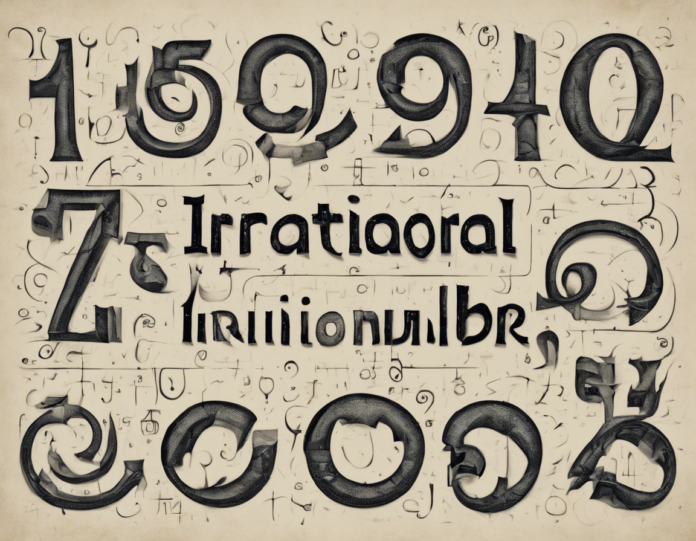Welcome to the world of real mathematics, where the exploration of numbers goes beyond simple integers and rational numbers to delve into the realm of irrational numbers. In this comprehensive guide, we will uncover the beauty and complexity of irrational numbers, examining their properties, significance, and applications in various mathematical contexts.
Understanding Irrational Numbers
What are Irrational Numbers?
In mathematics, irrational numbers are real numbers that cannot be expressed as a simple fraction of two integers. Unlike rational numbers, which can be written in the form a/b where a and b are integers and b is not zero, irrational numbers have decimal representations that neither terminate nor repeat. The most famous example of an irrational number is π (pi), which represents the ratio of a circle’s circumference to its diameter.
Properties of Irrational Numbers
- Non-Repeating Decimals: Irrational numbers have decimal representations that go on indefinitely without repeating a pattern.
- Uncountable: The set of irrational numbers is uncountably infinite, meaning there are more irrational numbers than there are natural numbers.
- Transcendental Numbers: Some irrational numbers, like e (Euler’s number), are transcendental, meaning they are not the roots of any non-zero polynomial equation with integer coefficients.
- Existence Between Rational Numbers: Between any two rational numbers, there exists an irrational number, highlighting the density of irrational numbers on the number line.
Importance of Irrational Numbers
Mathematical Constants
Irrational numbers play a crucial role as mathematical constants in various mathematical formulas and principles. Constants like √2 and e appear in equations related to geometry, calculus, and physics, providing precise and unchanging values for mathematical calculations.
Uniqueness and Continuity
The presence of irrational numbers ensures the completeness and continuity of the real number line. Without irrational numbers filling the gaps between rational numbers, the number line would have gaps and discontinuities, leading to a less cohesive and structured mathematical system.
Limitations of Rational Numbers
While rational numbers are useful for expressing fractions and exact values, many real-world measurements and calculations involve irrational quantities that cannot be accurately represented as fractions. Irrational numbers bridge this gap, allowing for more precise and exact calculations in various mathematical scenarios.
Applications of Irrational Numbers
Geometry
In geometry, irrational numbers appear in measurements of diagonals, side lengths, and areas of geometric shapes. For example, the diagonal of a unit square is equal to √2, an irrational number that highlights the incommensurability of the diagonal with the side length.
Trigonometry
Irrational numbers such as π and √2 are essential in trigonometric functions and identities. Sine, cosine, and tangent values for specific angles often involve irrational numbers, showcasing their significance in trigonometric calculations.
Physics
In physics, constants like the speed of light (approximately 299,792,458 meters per second) involve irrational values that play a fundamental role in relativity, quantum mechanics, and other branches of physics. These constants help describe the fundamental laws and phenomena of the natural world with precision.
Exploring Transcendental Numbers
Definition
A transcendental number is a real number that is not algebraic, meaning it is not a root of any non-zero polynomial equation with integer coefficients. Transcendental numbers are a subset of irrational numbers that exhibit unique and unpredictable properties.
Examples
Famous examples of transcendental numbers include π (pi), e (Euler’s number), and certain mathematical constants like Gelfond-Schneider constant. These numbers have infinite decimal expansions that do not follow a repeating pattern, distinguishing them from algebraic numbers.
Lindemann-Weierstrass Theorem
The Lindemann-Weierstrass theorem establishes that e raised to a non-zero algebraic power is transcendental. This result highlights the deep connection between exponential functions and transcendental numbers, offering insights into the nature of these complex mathematical entities.
Common Misconceptions about Irrational Numbers
Irrationality Implies Complexity
While irrational numbers are often associated with complexity and randomness due to their non-repeating decimal expansions, not all irrational numbers are transcendental or exhibit unpredictable properties. Some irrational numbers, like √2, are algebraic and satisfy simple polynomial equations, challenging the notion that irrationality always implies infinite complexity.
Limited Utility
Contrary to the belief that irrational numbers have limited utility in practical calculations, these numbers are pivotal in various mathematical, scientific, and engineering fields. From number theory to computer science, irrational numbers underpin countless algorithms, theorems, and applications, showcasing their versatility and relevance in diverse disciplines.
Frequently Asked Questions (FAQs)
- Can irrational numbers be negative?
-
Yes, irrational numbers can be both positive and negative, depending on their value. For example, -√2 is an irrational number that is negative.
-
Are all square roots irrational?
-
No, not all square roots are irrational. For example, √4 = 2, which is a rational number. However, square roots of non-perfect squares like √2 and √3 are irrational.
-
Can irrational numbers be expressed as fractions?
-
No, by definition, irrational numbers cannot be expressed as fractions of two integers. Their decimal representations are non-terminating and non-repeating.
-
Do irrational numbers repeat?
-
No, irrational numbers have decimal representations that do not repeat any pattern indefinitely. Unlike rational numbers, which have repeating or terminating decimals, irrational numbers are characterized by their non-repeating nature.
-
How are irrational numbers used in real-life applications?
- Irrational numbers are utilized in various real-life applications such as computer science, engineering, physics, and finance where precise and accurate measurements are required. Constants like π and √2 appear in calculations involving circles, triangles, waves, and more.
In conclusion, irrational numbers are not just mathematical anomalies; they are fundamental elements that enrich our understanding of numbers, patterns, and the universe itself. By exploring the intricacies of irrational numbers and their implications in mathematics and beyond, we unravel the mysteries and beauty of these enigmatic numerical entities.

